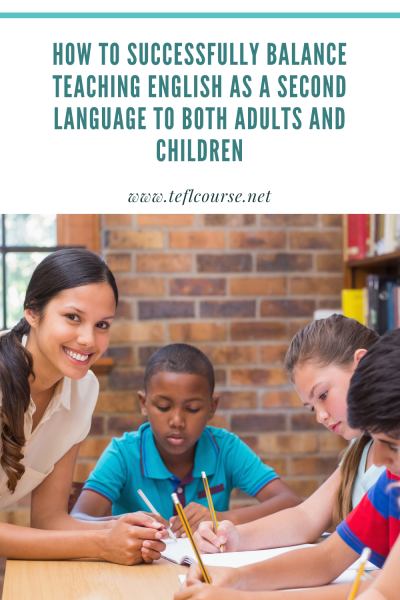How to Successfully Balance Teaching English as a Second Language to Both Adults and Children

Through my experience teaching in both a classroom setting and in a less formal setting, for example, teaching swim lessons, I have noticed that age affects how you are teaching materials. Using the swim lessons example, teaching a five-year-old how to swim will be much different from teaching an adult how to swim. You will use different techniques and be required to have a different approach. This is the same as teaching English as a Second Language. Teaching children a foreign language and teaching adults a foreign language will require different skills and energy. Throughout one's teaching career, teachers will likely have to balance between teaching children and teaching adults. Throughout this essay, I will explore finding this necessary balance in a career of teaching English.
This post was written by our TEFL certification graduate Landon H. Please note that this blog post might not necessarily represent the beliefs or opinions of ITTT.
Key-Points of Success
One of the first things that are required to be successful in teaching both children and adults is a positive attitude. Throughout the course, it was mentioned that students feed off of the energy that the teacher is giving off. This was especially evident when viewing the video observations of two different courses. For example, when the teacher in these videos did not have a very positive, energetic attitude it was evident that the students did not react positively to this. However, in the second video when the teacher was more active and engaged with his students they reacted better and participated in class more. Although having positive energy is necessary for both children and adults you will channel this energy in different ways. For example, teachers may have to be more silly or playful with children. While for adults, teachers may have to be more encouraging and motivational rather than playful.
Another key difference in teaching children versus adults is the way you are presenting materials. Children most likely have an extrinsic motivation for learning English so they need to be presented materials in a way they can easily engage with. This could include vocabulary games, interesting grammar sheets, and role-playing. Adults most likely have an intrinsic motivation for learning English and therefore may be more motivated. This means you can present the materials more straightforwardly.

Also Read: How do I choose a TEFL course?
Working With Adults
Adult students may advance more rapidly and as a teacher, you maybe have a wider variety of topics to discuss with them. When teaching adults it may be easier to have more conversational practice because this is the type of English learning and practice they are seeking out. When teaching children, the topics you are covering are more limited due to the appropriateness level and to cater to different interests. Another thing to balance between adults and children is the amount and type of outside work. Adult students may be more motivated to do outside work, or "homework", because they want to learn English at a quicker rate or want to practice more. Students who are children may not wish to complete traditional "homework" so it may be better to give them outside work that is interesting or fun. These are a few things to take into consideration when balancing between teaching children and teaching adults.
Do you want to teach English abroad? Take a TEFL course!
Apply now & get certified to teach english abroad!
Speak with an ITTT advisor today to put together your personal plan for teaching English abroad.
Send us an email or call us toll-free at 1-800-490-0531 to speak with an ITTT advisor today.
Related Articles:
- The Top 5 Places to Teach English in Japan | ITTT | TEFL Blog
- 10 Questions You Need to Ask Before Enrolling In a TEFL Course
- Step-By-Step Guide To Legally Teaching English in South Korea
- Online or In-Class - Which TEFL Course Should You Take?
- Teaching English Abroad: What's Next? - How To Advance In Your EFL Career
- Teaching English In China - The Salary and Budget Guide




